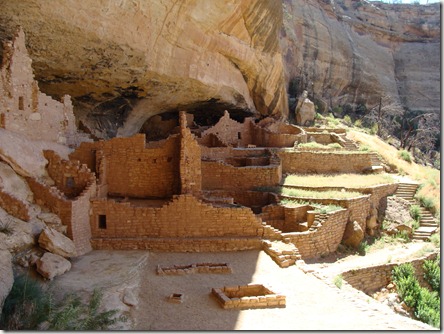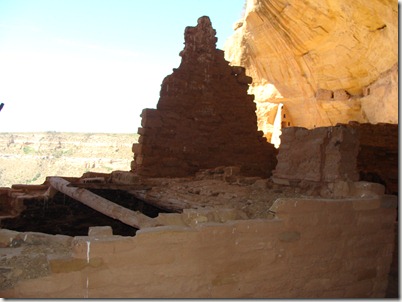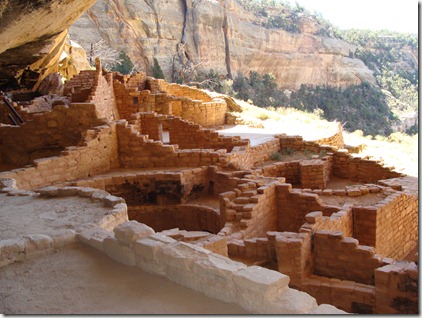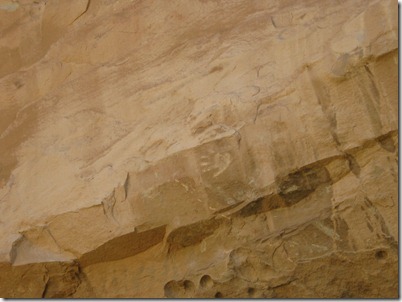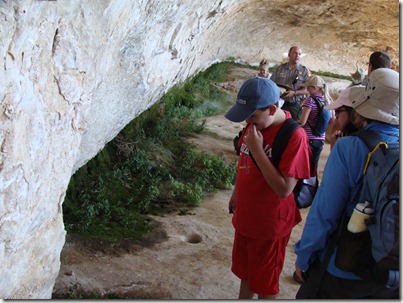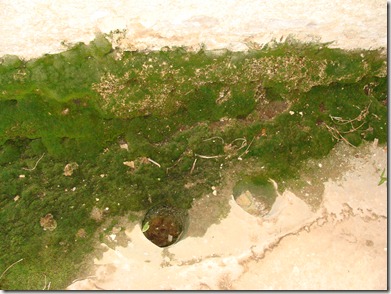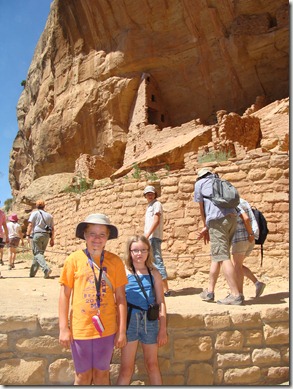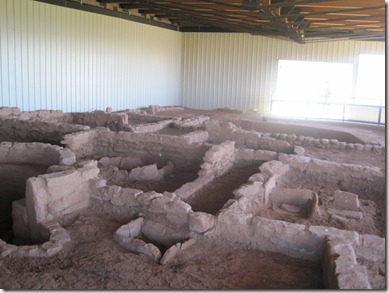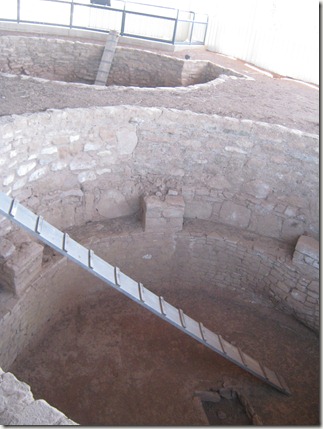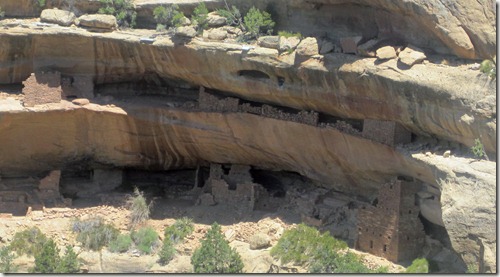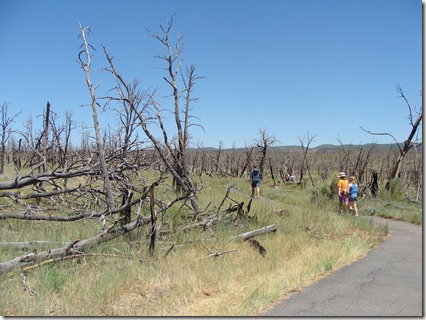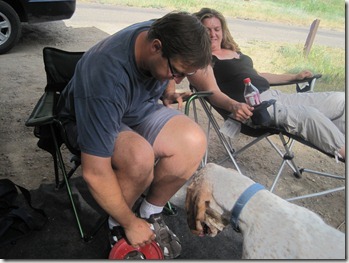Saturday, July 17, 2010 (Mesa Verde, pt II)
Someone asked the other day why Buster was in some of our pictures but missing from other stops. Easy answer: in national parks, dogs are allowed in your campsite, but that’s about it. No dogs on trails, in buildings, etc. This makes sense because dogs do dumb things and generally don’t get along with bears, snakes, mountain lions, etc. It’s just not safe to have them around. We DO want to get on those trails and in the buildings, though, so when possible, Buster has spent time in doggy daycare while we explore the parks. If we need to do something at night or early morning, he has stayed overnight in the kennel.
So that’s our logistical situation today. We wanted to do two cliff dwelling hikes yesterday, so we dropped Buster off at the Cortez Animal Bed & Breakfast around noon. Today we got an early start to catch an early tour for our third hike before we picked the dog up in the afternoon. All of this is, of course, complicated by the fact that the entire park is under construction. The 11 miles from the campground to the visitor’s center can take an hour and a half.
The Long House tour started at 10 am at the furthest point from our campsite. We skipped a real breakfast, feasted on granola bars, and started driving at 8:15 . . . . . . . only to sail by all of the construction equipment that sat silent . . . because nobody works on Saturday. We’ve totally lost track of the days. No traffic back-ups meant we had some extra time while we waited for our tour.
Elizabeth & Julia climb the ladder into Long House
Long House is unique because of all the cliff dwellings in the park, it stretches the furthest across the rock face. Unlike the others where the floor is divided into kivas and living quarters, a large portion of Long House is open space with a central fire pit and was likely a dance area reserved for weddings or other ceremonies.
We later got a distant look at Long House and could appreciate its size along the cliff face
Looking down at the central fire pit/ceremonial area
A rare kiva: This one still has part of its wooden/mud roof
The Long House tour focused on family life for the people who lived here. Using two young pre-teens on the tour (who looked horribly embarrassed), the ranger asked them to imagine they were getting married and what they would have to do to prepare. While they gave modern day answers, he redirected them to how the process would have worked if they lived with the Ancestral Puebloans: A marriage partner chosen around age 10, two years to gather food for the celebration, married at 12-14 years, children immediately, dead by age 30. It was a quick and difficult life.
The ranger expanded on the health challenges of the ancient people. Surprisingly, even through most of this, Julia thought the cliff dwellings would be a great place to grow up. We heard, “Cool! I want to live here!” a lot. Only one ailment gave her pause. Constant tooth pain because of sandstone in the cornmeal? No problem. Everyday danger of falling off cliffs? Just gotta be careful. Continual dehydration and possible starvation during a 25-year drought? Tough, but you could make it work. It was finally the ranger’s description of chronic, incurable pinworm that made her face scrunch up in horror. No matter how cool the houses were, “that itchy butt disease” is just not worth it – she is outta there.
Missing its walls, you can see the many rooms once a part of the whole structure
We found it very interesting that although the people left no written records, answers to how they lived are still found in the stories and traditions of their current descendants. For example, when archaeologists were trying to figure out why the dwellings have mud splatters at high points along family walls, they found the answer by asking today’s Hopi people. Apparently, it is still an understood custom for the mothers and aunts of a young man who has just been married to go to his new home (in 1100 AD he would move in with his new wife and her family) and throw mud balls in a playful display of mock anger toward the new family for “stealing” their son.
The mud ball splatters don’t show up well here, but a child’s handprint gives evidence the rooms once reached high into the alcove
Long House was fun to explore because of its size. Also interesting was seeing the spring used as its water source is still producing water. It’s just puddles on the floor, but historians expect when people lived here, there were few trees on top of the mesas competing for the water. When trees don’t use the water, it filters through the sandstone, hits the hard limestone, and runs along the floor into small pools.
Moss and small plants offer clues to Long House’s water source
Holes carved in the floor were used to collect running water
After our tour of Long House, we reboarded the tram escorting people between sites and got off at several other stops to see preserved ruins and overlooks for other cliff dwellings. The mesa top dwellings were an interesting contrast to those built into the sides of cliffs. They were built much earlier, so there was often evidence of “remodeling” over time. The park has a handful of these sites on display, but they may one day have more. When the fires moved through 8-10 years ago and removed vegetation, more than 500 new mesa top sites were discovered.
Before the Ancestral Puebloans moved their homes onto the side of cliffs, they had similar homes on the mesa tops. Several of these are preserved and protected from the sun
Two kivas in a mesa top dwelling
Kodak House from the opposite side of the canyon
A closer look at Kodak (no tours here, so only pictures from far away)
The tram driver pointed out the obvious damage done to the park by the fires in 2000 and 2002.
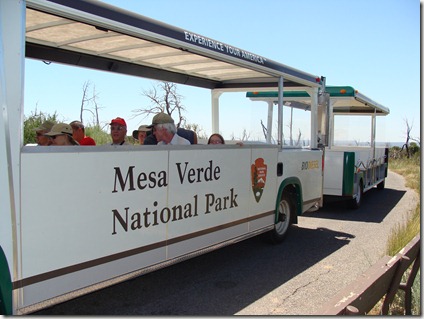 Mesa Verde transportation (Julia’s head is above the “e” in “Verde”)
Mesa Verde transportation (Julia’s head is above the “e” in “Verde”)
Fire damage everywhere
Two interesting things here. First, with less than 18 inches of rain each year, summer foliage is rather crispy and burns easily. When fires start, they burn hard and high. When the “Pony” fire of 2000 reached the canyon near Kodak House, it leaped right across the canyon and didn’t stop. Second, conditions in the park are good for a fire all summer long. All fires so far have been caused by lightning. When lightning strikes a tree, it first heats up the roots. Several days later the tree will burst into flames. Therefore, when storms move through, the park assumes trees have been struck by lightning. Helicopters with heat sensors fly over the next day and firefighters make visits to hot spots all the time; the most recent fire to be put out happened 2 days ago! Finally, this vegetation is just different than what we see in Michigan. The most common tree in the park is the Juniper – an extremely slow-growing tree. We were shown seedlings that sprouted up after the 2000 fires, but after ten years of growth, they are only about a foot tall (not a lot different from the trees trying to grow in the heavy clay soil in my yard back in Michigan). They will need almost 200 years to reach maturity. Fires are a big deal simply because a forest in Mesa Verde will not recover in the same time as a burned area of Yellowstone. While Yellowstone trees need occasional fires to seed new growth, Mesa Verde’s Juniper trees do not.
We needed to pick up Buster by 4:00, so we packed up the computers and drove into Cortez. The Welcome Center there had comfy chairs and an internet connection we could use, so the while Mike and I worked on pictures, email, etc., the girls played games and read books (Julia is really into Sherlock Holmes right now, so she stops occasionally to brief us on random murder investigations – she was super geeked to find one story focused on the Mormons moving into Zion, a historical period she had just learned about when we visited Zion). After gathering the dog, I dropped everybody off at the city park while I picked up a few groceries (Score! Safeway stores are Kroger stores so I can finally use a shopper’s card and not pay ridiculous prices – yeah!). Cortez is a neat little town. I dropped everybody at one park, but they could have easily walked to three others all neighboring one another and set around ponds and schools. Good place to walk the dog.
Relaxing while the kids do dishes
Driving back through town on our way to Mesa Verde (less than 10 miles away), we passed almost a dozen little Mexican restaurants. Everybody was pushing for another salsa test, but I just bought groceries, darn it. That will have to wait ‘til tomorrow when we reach our next and final destination: Moab, Utah. Tonight we made a campfire, grilled hamburgers, and relaxed.



